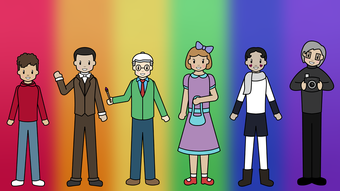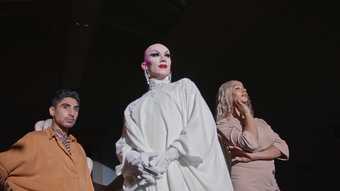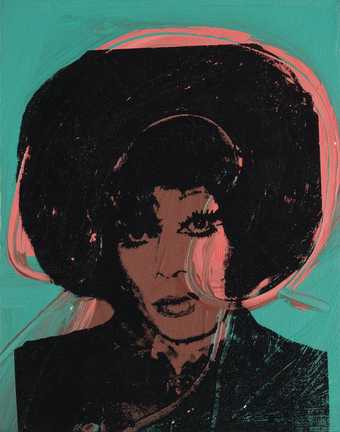
Andy Warhol
Ladies and Gentlemen (Helen/Harry Morales) 1975
Italian private collection © 2020 The Andy Warhol Foundation for the Visual Arts, Inc. / Licensed by DACS, London.
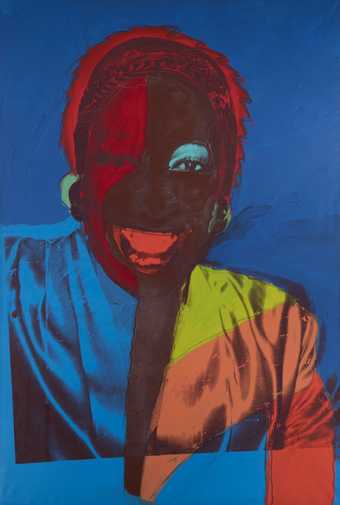
Andy Warhol
Ladies and Gentlemen (Wilhelmina Ross) 1975
Italian private collection © 2020 The Andy Warhol Foundation for the Visual Arts, Inc. / Licensed by DACS, London.
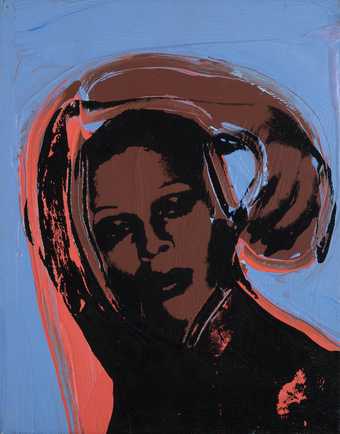
Andy Warhol
Ladies and Gentlemen (Iris) 1975
Italian private collection © 2020 The Andy Warhol Foundation for the Visual Arts, Inc. / Licensed by DACS, London.
Andy Warhol was fascinated by the famous. Jackie Kennedy, Marilyn Monroe and Elvis Presley are among the many celebrities who feature in his work.
But the people in his Ladies and Gentlemen series are not so well known. For decades they were unlabelled and anonymous. It took until 2014 for researchers to uncover their names and identities – and we still know very little about many of them.
Warhol was commissioned to make the series by an Italian art dealer called Luciano Anselmino, who suggested a series of ‘impersonal, anonymous’ pictures of ‘transvestites’ and came up with the theatrical title ‘Ladies and Gentlemen’.
The subjects were recruited by Warhol’s friends, many from the Gilded Grape, a bar on Manhattan’s 8th Avenue. It was a popular hangout for New York’s Black and Latinx trans women and drag queens. It was close to Warhol’s studio, known as The Factory, and he would sometimes take clients there for a look at Manhattan’s nightlife.
Warhol took over 500 photographs of 14 models. He often sifted through the Polaroids with the sitter to find the ones they both thought worked well. A selection of them were then enlarged onto silkscreens.
The result was a large group of paintings that deviated from the original proposal in favour of an exploration of performance, glamour and personality. However, there are still questions about the ethics of this series – it documents a community Warhol was not a part of, with subjects having little agency in how they were depicted or where the works would be shown. An interview with one of the sitters, Marsha P. Johnson, in the Village Voice in 1979 points out the irony of her walking past a gallery with her portrait on sale for many thousands of dollars while she was struggling to afford a place to live.
We know the names of some of the models because Warhol asked them to sign their Polaroids. A number would have been known in the gay and trans scenes. In 2014 the Warhol Foundation published an official list of all of the Ladies and Gentlemen paintings. This featured the names of 13 out of the 14 sitters for the first time that they were able to identify: Alphanso Panell, Broadway, Easha McCleary, Helen/Harry Morales, Iris, Ivette, Kim, Lurdes, Marsha P. Johnson, Michele Long, Monique, Vicki Peters and Wilhelmina Ross. The identity of the fourteenth model remains unknown.
Seven of these models feature in the works in the Andy Warhol exhibition at Tate Modern: this is what we know of their stories.
Naming
Since it is not possible to know how the models in the series would have self-identified, we are using the terms drag queen and trans woman. At the time Warhol made these pictures, the terms drag and trans were used, but often in a different way from today.
We have chosen to use the pronouns she, her, hers when referring to the subjects unless we know otherwise. Based on what we know of some of the sitters, it seems likely that this would have been their preferred pronoun. Some of them performed in drag productions, but they also lived much of their lives as women.
Broadway
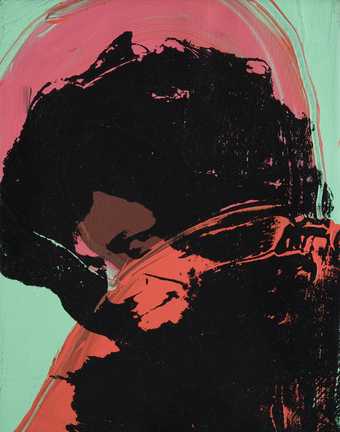
Andy Warhol
Ladies and Gentlemen (Broadway) 1975
Italian private collection © 2020 The Andy Warhol Foundation for the Visual Arts, Inc. / Licensed by DACS, London.
Warhol created 19 paintings of Broadway from an original selection of 47 Polaroids. She signed one of her Polaroids but we don’t have any more information about her.
Iris

Andy Warhol
Ladies and Gentlemen (Iris) 1975
Italian private collection © 2020 The Andy Warhol Foundation for the Visual Arts, Inc. / Licensed by DACS, London.
During their photoshoot, Warhol took 36 Polaroids of Iris, three of which he went on to use for 26 paintings. While Iris did not sign her Polaroids, she has been identified by Corey Tippin, who was part of the Warhol scene in the early 1970s and knew Iris personally. We know very little about Iris’s life. She may have moved to Paris in 1977.
Marsha. P Johnson
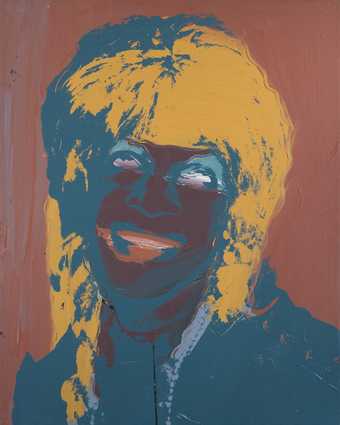
Andy Warhol
Ladies and Gentlemen (Marsha P. Johnson) 1975
Italian private collection © 2020 The Andy Warhol Foundation for the Visual Arts, Inc. / Licensed by DACS, London.
Marsha P. Johnson is the most famous subject in the Ladies and Gentlemen series, although Warhol only created two paintings of her. She was a fixture of the West Village scene and was often referred to as ‘Saint Marsha’ – when asked by a judge what the P. in her name stood for, she replied it stood for ‘Pay it no mind!’. She is believed to have been a key figure in the Stonewall Uprising, which helped to usher in the gay and trans rights movements. Meanwhile, together with Sylvia Rivera, she founded the Street Transvestite Action Revolutionaries (S.T.A.R), which offered support to homeless gay and trans youth. She continued to fight for LGBTQ+ rights throughout her life, as well as performing as part of the drag revue Hot Peaches. In 1992 Johnson was found dead in the Hudson River – many believe she was murdered.
Lurdes
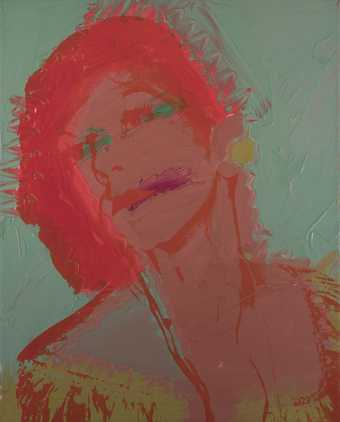
Andy Warhol
Ladies and Gentlemen (Lurdes) 1975
Italian private collection © 2020 The Andy Warhol Foundation for the Visual Arts, Inc. / Licensed by DACS, London.
This painting is one of 28 portraits Warhol made of Lurdes. We don’t know anything more about her. As with many of Warhol’s works from the early 1970s, he uses his fingers to mix areas of colour. The orange screenprint ink in this work makes the green background more visible, which makes it difficult to know which layer was added first.
Helen/Harry Morales
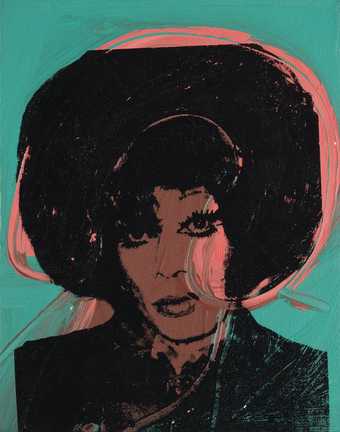
Andy Warhol
Ladies and Gentlemen (Helen/Harry Morales) 1975
Italian private collection © 2020 The Andy Warhol Foundation for the Visual Arts, Inc. / Licensed by DACS, London.
Morales signed one of her Polaroids as Helen Morales, and one as Harry Morales. Corey Tippin met Morales at the Gilded Grape. Warhol enjoyed Morales’s sitting so much that he asked her to return the following day, where she appeared without the bouffant wig. Warhol made 31 paintings of Morales and took 42 Polaroids.
Alphanso Panell
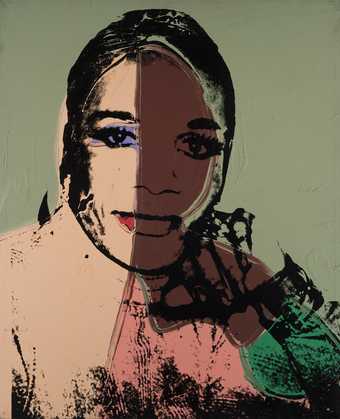
Andy Warhol
Ladies and Gentlemen (Aphanso Panell) 1975
Italian private collection © 2020 The Andy Warhol Foundation for the Visual Arts, Inc. / Licensed by DACS, London.
After Wilhelmina Ross, Warhol made the largest number of portraits of Panell – 60 paintings out of seven Polaroids. We know Panell’s identity because she signed her Polaroid, with what is thought to be her birth name. Not much more is known about her. Jimmy Camicia, co-founder of the Hot Peaches theatre company recalled, ‘Many years ago, while walking with Marsha [P. Johnson], she stopped to talk to Alphanso… They were friends. My impression was that she was very soft spoken, gentle and kind.’
Wilhelmina Ross
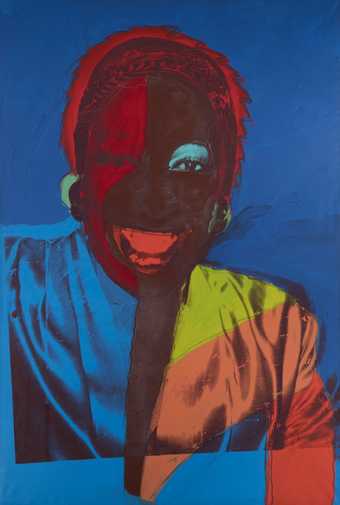
Andy Warhol
Ladies and Gentlemen (Wilhelmina Ross) 1975
Italian private collection © 2020 The Andy Warhol Foundation for the Visual Arts, Inc. / Licensed by DACS, London.
Ross appears to have been Warhol’s favourite model for Ladies and Gentlemen. He made 73 paintings, based on seven Polaroids, 29 drawings, and five collage portraits of Ross. He also created five giant 10-foot canvases of her. Ross was born Douglas Mitchell Hunter in Kansas City, Missouri, moving to New York in 1970. Her name was a mix of the model agency Wilhelmina and Warhol’s close friend Diana Ross. After Jimmy Camicia saw her in an off-off Broadway production, where she was pretending to be a cockroach, he asked her to join his drag theatre company. She soon became a leading star and worked with them around the time Warhol made her portrait. At the end of 1974 Ross moved to Puerto Rico in 1974, where she lived for ten years. When she learned she had AIDS, she returned home to her mother where she was nursed for the last two years of her life.


